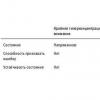Syphilis. Seroresistance after treatment: disease or condition? How is seroresistance diagnosed?
The article discusses issues related to the mechanism of the emergence of seroresistance, its diagnosis and the doctor's tactics while maintaining positive reactions after treatment.
The current specific treatments for syphilis do not always lead to negative serological tests. The seroresistance is due to many reasons. The paper deals with issues pertinent to the mechanism responsible for the occurrence of seroresistance, to its diagnosis, and management when posttreatment positive tests are retained.
S.I. Dovzhansky - Prof., Doctor of Medical Sciences Sci., consultant dermatovenerologist of Saratov medical center"Health" RAO "Gazprom"
S.I.Dovzhansky - prof., MD, Consulting Dermatovenereologist, Saratov Medical Center “Zdorovye”, Gazprom Russian Joint Stock Company
V
In connection with a significant increase in the incidence of syphilis, attention is now being paid to the diagnosis and treatment of the disease not only by venereologists, but also by specialists in many branches of medicine (neuropathologists, therapists, pediatricians, ophthalmologists, etc.).
Syphilis is very diverse, characterized by a rich palette of manifest and latent forms, polysyndromic lesions, the recognition of which is based on a comprehensive clinical and laboratory examination of the patient. At the same time, serological studies that provide objective information are of particular importance, providing timely and high-quality diagnosis of the disease. In our country, serodiagnosis of syphilis is unified and mandatory in establishing the etiological diagnosis, dynamics of the disease, planning treatment measures and quality control of treatment.
Historical reference.
In 1906 A. Wasserman et al. for the first time used the complement fixation reaction (CSC) for the diagnosis of syphilis. As an antigen, the authors used an aqueous extract from the liver of a fetus affected by syphilitic infection. Currently, cardilipin and treponemal antigens are used for CSCs. In 1949 R. Nelson and M. Mayer proposed a reaction of immobilization of pale treponemas (RIBT), which is based on the phenomenon of cessation of mobility of treponemas when mixed with the patient's serum. The reaction of immunofluorescence (RIF) for the detection of anti-treponemal antibodies was first used by W. Deacon et al. in 1957. Subsequently, modifications were proposed (RIF-200, RIF-abs), for the detection of antigens and antibodies - enzyme-linked immunosorbent assay (ELISA), reaction passive hemagglutination(RPGA), microprecipitation reaction (RMP). Sedimentary reactions (Cana and cytocholic) have not lost their significance.
In practice, for the diagnosis of syphilis and serocontrol in the process and at the end of treatment, a standard complex of serological reactions (CSR) is used: RSK with treponemal and cardiolipin antigens and a microreaction of precipitation with cardiolipin antigen. In addition, RIBT and RIF are also used to clarify the diagnosis, identify false-positive results, when establishing cure and when deregistering.
It should be noted that the results of serological reactions cannot have an independent diagnostic value, they only allow, in combination with the clinic, to correctly navigate in the diagnosis and correctly assess the quality of treatment in a particular patient. “Serological mirror” is one of the most important criteria for cure in persons who have had syphilis.
Evaluation of the results of seroreaction indicates that one of the earliest signs of the primary period of syphilis is the emergence of antibodies against treponema pallidum, determined in the RIF, while the DAC remains negative. Later, 6 weeks after infection, as the syphilitic infection develops, the remaining reactions (CSR, RIBT) gradually become positive. If, with clinically pronounced forms of active syphilis, seroreactions make it possible to confirm and clarify the diagnosis, then with latent forms they are the main and often the only criterion. The dynamics of seroreactions in the course of treatment, manifested in a decrease in the titer of reagins in the DAC, and the subsequent negative reactions indicate a favorable treatment result. The rate of CSC negativity is highly variable in different patients. In most patients with fresh forms of syphilis, standard seroreactions become negative in the first 4-6 months after penicillin therapy: with the primary seropositive period of syphilis in 1/3 of patients - after 2 - 3 months, with fresh secondary - after 7 - 8 months, with secondary recurrent early latent - after 10 - 12 months and later. RIF and RIBT are negatively negative much more slowly (after 3 - 4 years).
At the end of treatment of patients with late forms of syphilis (late latent, visceral, neurosyphilis, late congenital syphilis), CSF and especially RIF and RIBT can remain positive throughout their lives.
Numerous observations indicate a possible delay or the presence of persistently positive seroreactions even in patients who were vigorously treated for early forms of syphilis (primary seropositive, secondary and latent syphilis). The number of such cases increases as the duration of the disease increases, that is, the period from the moment of infection to the start of specific therapy. This circumstance raises an extremely important problem concerning the development of seroresistance of syphilis, the interpretation of which is very contradictory.
Seroresistance indicates persistent immunobiological changes in the body of a patient who has undergone syphilis, and is not always an indicator of incomplete treatment. Therefore, the diagnosis “seroresistant syphilis” cannot be considered correct. We join the opinion of other authors who consider it more acceptable definition - “seroresistance after syphilis treatment”.
Seroresistance was noted already in the first years after the introduction of seroreactions in the diagnosis of syphilis in the pre-penicillin era and is currently encountered with a frequency of 1.5 to 20% (according to different authors). The establishment of seroresistance is based on the results of the entire complex of seroreactions (CSR, RIBT and RIF). In those cases when, after a full-fledged treatment, positive reactions of RIBT persist with the onset of negative CSR, according to some authors, there is a so-called trace reaction or “serological scar”. The presence of an infectious process is denied. Meanwhile, the experimental studies of P. Collart et al. showed that late started treatment, even a high-quality one, is not able to completely eliminate all pale treponemas in the patient's body, which remain in enclosed foci in the form of low-virulent or non-virulent forms. However, there is a point of view according to which seroresistance can be caused by autoimmune processes in the body. According to I.P. Masetkina et al. , when carrying out specific etiotropic treatment of syphilis, like other infectious diseases, the pathogen (antigen) initially disappears from the patient's body, while the changes in the body caused by the disease (including antibodies) disappear much later ( persistence of antibodies) or do not disappear at all.
Among the causes of seroresistance are: 1) initiation of treatment in the late stages of syphilis; 2) inadequate treatment (insufficient daily and course doses of anti-syphilitic drugs; 3) the presence of concomitant infections and somatic diseases; 4) chronic alcohol intoxication; 5) drug use; 6) "background" immunosuppression - a violation of immunity under the influence of external or genetic factors.
N.M. Ovchinnikov et al. it is believed that seroresistance is favored by the following conditions: the presence of an accompanying flora that produces penicillinase, neutralizing the penicillin introduced into the body; the transition of pale treponemas to L-forms, cysts, granules, difficult to the action of penicillin; finding treponemas in polymembrane phagosomes of body cells that are inaccessible to antibiotics; metabolic disease; the presence of treponemas in encapsulated foci. Consequently, there is no reason to believe that seroresistance is a kind of “cosmetic defect” of the blood; it occurs against the background of significant disorders of the immune system. Studies have shown that with seroresistance in the body of patients, there are signs of incomplete elimination of the treponemal antigen. This is largely due to the imbalance and dysfunction of the cells of the immune system. Changes more significant are found in persons treated for recurrent and early latent syphilis. These shifts in immunity are characterized by an increase in the level of IgG and specific IgM, as well as an increase in the production of IL-1 and IL-2, which indicates the presence of specific antigenic stimulation. In some cases, the function of the T-cell link of immunity is impaired due to the activation of T-suppressors and a decrease in the helper function.
According to the instructions, seroresistance is established if CSR remain positive for 12 months or more after treatment.
Analysis of numerous data made it possible to identify three variants of seroresistance after treatment: true, relative and pseudo-resistance. True resistance
usually occurs in patients treated for fresh forms of syphilis, mainly secondary recurrent and latent syphilis (disease duration up to 6 months). In these patients, there are fluctuations in the antibody titer during treatment, but the complete negative seroreaction does not occur. Thorough examination reveals specific changes internal organs and nervous system(a study of the cerebrospinal fluid is necessary). Seroresistance in them is due to the persistence of pale treponema in the body, which has antigenic properties. In this case, there is a progressive course of syphilitic infection. Such patients are subject to etiotropic and immunocorrective therapy. For the treatment of true seroresistance, antibiotics are additionally used according to the treatment regimens for secondary recurrent syphilis. In addition, immunomodulators (decaris, methyluracil, pyrroxan, T-activin, etc.), pyrogenic drugs (pyrogenal, prodigiosan), vitamins, biogenic stimulants (aloe, vitreous). According to clinics in St. Petersburg, treatment with massive doses of penicillin administered intravenously is effective. The observation period for true seroresistance is 5 years.
Relative seroresistance
is established in treated patients with secondary recurrent and early latent syphilis (duration of the disease more than 6 months). It is believed that this variant of seroresistance is associated with the presence of low- and avirulent cysts and L-forms in the body. Additional treatment does not alter seroreaction rates. If seropositivity persists after treatment of patients with late latent or late congenital syphilis, then this can often be considered a sign of relative seroresistance, in which only immunocorrective therapy is indicated.
Finally, pseudo-resistance
differs in the complete absence of the causative agent of the disease in the body. Its essence remains to be studied. In this regard, the work of S.I. Danilov, which shows the importance of immunological mechanisms in the formation of seroresistance in syphilis. The author proposed to determine the degree of activity of the process using the IgM-RIF-abs and ELISA-abs tests, which makes it possible to differentiate the true seroresistance from its other variants. It has been shown that one of the reasons for relative seroresistance is network idiotypic relationships in the immune system with the development of autoantiidiotypic antibodies directed to antibodies to treponema pallidum that do not respond to antibiotic therapy. They are able to induce a specific immune response and persist after the disappearance of the infectious factor (“immune memory”).
The problem of seroresistance is closely related to the diagnosis of latent forms of syphilis and persistent "chronic" false positive reactions in healthy individuals or patients with other diseases (malignant neoplasms, leukemias, diseases connective tissue, cirrhosis of the liver, leprosy, malaria, etc.). An incorrect interpretation of the results of seroreaction often leads to gross diagnostic errors, which entail dramatic and even tragic situations. In this regard, a timely, thorough and comprehensive examination before treatment plays an important role in order to avoid the frequent overdiagnosis (especially of unknown syphilis, lues ignorata). All errors and inaccuracies can be eliminated with close contact between clinicians and laboratory assistants. At the same time, the differential diagnostic value of serological reactions is especially clearly revealed when titrating the studied blood sera. Elevated titers of reagins and antibodies are more typical for syphilitic infection, while titers of false positive reactions are often low (1: 40) and unstable, although in 3 - 5% they may be higher (from 1: 160 to 1: 640).
In conclusion, we consider it necessary to note that modern antibiotic therapy has finally decided the question of the curability of syphilis. Meanwhile, the use of massive doses of penicillin and its prolonged drugs has a significant effect on reducing the immunity of patients, moreover, durant drugs (retarpen, extencillin, etc.) in therapeutic doses do not penetrate the blood-brain barrier. They may not be effective enough in the treatment of patients with signs of damage to the nervous system, even in early stages syphilis. In addition, the emergence of resistant forms of the pathogen to macrolides is known. All this must be taken into account when deciding on the causes of seroresistance after treatment.
Literature:
1. Frishman M.P. On serological resistance after treatment of syphilis patients. Vestn. dermatol. 1984 .-- 7. - S. 32-4.
2. Ilyin I.I., Yarovinsky B.G., Galeeva A.S. Doctor's tactics while maintaining positive seroreactions after treatment of early forms of syphilis. Vestn. dermatol. - 1984 .-- II. - S. 57-61.
3. Collart P, Borel L, Durel P. Significance of spiral organisms found, after treatment in latt human and experimental syphilis. Brit J Vener Dis 1964; 40 (2): 81 - 9.
4. Sokolovsky E.V. Serological resistance after syphilis treatment (causes and factors of development, prevention and treatment). Abstract of thesis. dis. ... Dr. med. sciences. St. Petersburg. - 1995. - C. 40.
5. Masetkin I.P., Reznikova L.S., Luchnikova T.A., Elkin V.D. Serodiagnosis of syphilis. Permian. - 1977 .-- S. 195.
6. Ovchinnikov N.M., Bednova V.N., Delektorsky V.V. Laboratory diagnostics sexually transmitted diseases. M., Medicine. - 1987 .-- S. 303.
7. Milich M.V. Serological resistance in syphilis. Moscow. - 1984. - C. 48.
8. Milich M.V. Evolution of syphilis. M., Medicine. - 1987 .-- S. 158.
9. Dovzhansky S.I. Syphilis. Saratov. - 1993 .-- S. 68.
10. Danilov S.I. Diagnostic criteria, immunocorrection and rehabilitation of patients with seroresistance after syphilis treatment. Abstract of thesis. dis. ... Dr. med. sciences. St. Petersburg. - 1996 .-- S. 38.
Hello! In 2004, she underwent treatment at the RW KVD positively for syphilis. In 2007, it was removed from the register in 2012, the last check in the KVD, the venereologist gave a certificate of a serological scar and noted that it could not be treated. When tested according to Westerma on RW, the results are negative. Now at 8-9 weeks of pregnancy, can this somehow affect the fetus, what are the consequences? And is it necessary to report a serological scar to the gynecologist leading the pregnancy?
popova lena, khabarovsk
ANSWERED: 04/20/2013
In due time, your blood should be tested for syphilis. If the results are positive, you will be referred for a consultation with a venereologist. If you are cured, there is no threat to the child.
Clarifying questionSimilar questions:
| date | Question | Status |
|---|---|---|
| 26.05.2015 |
I am 32 years old, height 162, weight 49, woman. For quite a long time I suffer from periodic constipation, with their exacerbation, pains in the lower abdomen on the left begin, which intensify during bowel movements. Recently I have been going to the toilet with the help of candles, or regulation. Only after adjusting the seal in sigmoid colon passes. And so it is always compacted to the touch. Seal at the very bottom left. Everything is fine in gynecology. The pain is mild, drawing with gas and constipation. At one time I adjusted a chair, but ... |
|
| 07.08.2014 |
Hello! On November 26, 2013, I had an abortion due to honey. Indications (cleft and lip and palate, violation of the genitourinary system). It has already been 9 months that we really want to get pregnant, but every month I see only my periods. The last three months the cycle May-June is 33 days, June = July-28 days, July-August 32 days. Tell me how to be. I did an ultrasound scan after giving birth and after the postpartum cleaning they said that everything was in order. But pregnancy does not work, already nerves to hell and tears with every visit ... |
|
| 29.07.2016 |
Good day! I was diagnosed with an incompetent scar after caesarean section(2.2 mm) and through the only right tube the patency with great difficulty (according to hydrosonography). The left one was removed earlier due to an ectopic pregnancy. They are sent for scar plasty and removal of adhesions in the tube using laparoscopy. What should I do? Can I get pregnant and carry it on my own? |
|
| 09.10.2015 |
Hello! I am 36 years old, pregnancy is 30 weeks second, second birth, myoma is about 10 cm closer to the isthmus, a scar on the uterus after myomectomy in 2013. According to the ultrasound, everything is fine with the child, myoma hurts. Please tell me, with this location of the node, is it better to do a cesarean or try to give birth yourself? And if you do a cesarean, then go to the hospital in advance or wait for the onset of labor? Thanks. |
|
| 22.10.2014 |
Good day! I am 22 weeks pregnant. Everything is going well, without complications, ultrasound, etc. Everything is normal. A few days ago, a vaginal swab was taken at the antenatal clinic. Today they said that they found staphylococcus and thrush. This horrified me t. K. They said that it is dangerous for the baby and for me, especially staphylococcus aureus for the baby. They attributed "FURADONIN" I bought it as the doctor prescribed for me, but the instructions say that it cannot be used during pregnancy and feeding and that it can be ... |
Traces after syphilis can be found in almost any serological study.
Among them:
- RIBT;
- immunoblot.
The main reasons for this phenomenon:
- inadequate treatment;
- late treatment of the patient and, as a result, late treatment started;
- the patient has concomitant infectious diseases, the causative agents of which may have an antigenic similarity to treponema pallidum (tuberculosis, malaria);
- preservation of lesions of syphilis that are inaccessible to exposure antibacterial drugs, but do not manifest themselves clinically;
- the transition of pale treponema to alternative life forms (L-forms, granules, cysts) with their long-term preservation in the human body;
- finding the causative agent of syphilis in the polymembrane phagosomes of cells, as a result of which they become bacteria resistant to either antibiotics or immunoglobulins;
- lipid metabolism disorders.
There is also a theory that the traces of syphilis are due to autoimmune reactions.
Total antibodies - a trace of syphilis
One of the commonly used reactions to diagnose syphilis is this. The total antibodies M and G are determined.
The result can be positive or negative.
If the test is positive, this does not necessarily indicate syphilis. As we have already found out, this may be just a serological scar. In addition, a number of diseases provoke false positive reactions.

Among them:
- myocardial infarction;
- autoimmune pathologies;
- HIV, hepatitis and a number of other infections;
- pregnancy;
- liver disease, etc.
Therefore, ELISA is a screening and not a confirmatory method. No diagnosis is made on the basis of this analysis alone.

RPGA - trail of syphilis
RPHA can be used as a screening or confirmation test. It is carried out by a qualitative or semi-quantitative method.
The qualitative method allows you to get only two types of results: it can be positive or negative. This method is suitable for primary diagnosis syphilis.

But it is not suitable for examining persons who have already been treated for this disease. They use a semi-quantitative RPGA.
It gives three kinds of results:
- there are no antibodies - the disease is cured, there are no traces of syphilis;
- the antibody titer is more than 1: 640 - the patient has an active infection;
- the antibody titer is less than 1: 640 - these are traces of syphilis, most likely the person has recovered.
RIBT and RIF trail of syphilis
allows you to get the following gradation of results:
- positive;
- weakly positive;
- dubious;
- negative.
If syphilis is active, it will be positive.

With a previous illness, it may be dubious or weakly positive.
RIF is another confirmatory test with high sensitivity.
The transition of a positive RIF to a negative one is a guarantee of a person's cure. But the result of this study can remain positive even if the pathogen is completely eradicated by antibiotics.
Immunoblot - trail of syphilis
Immunoblot is one of the most reliable methods for diagnosing syphilis. Antibodies IgG to the antigens of treponema pallidum separated by electrophoresis are investigated.
The result can be positive, negative, or indeterminate. In the presence of immunoglobulins, the immunoblot reaction may be false positive.

How to remove traces of syphilis from the blood?
Some patients seek to get rid of traces of syphilis. Unfortunately, this is not possible.

Neither a repeated course of antibiotic therapy, nor procedures for extracorporeal blood cleansing (plasmapheresis and others) can overcome seroresistance. But there is nothing terrible in the presence of a serological scar. Antibodies are not harmful to human health. If you need to get tested for syphilis, please contact our clinic. We have all the latest research available.
If you suspect syphilis, contact a competent venereologist-syphilidologist.
At present, seroresistance after a full-fledged treatment of syphilis is understood as a certain state of the body, which is characterized by the absence of a decrease in the titers of reagins in the RM (precipitation microreaction) by 4 times or more within a year after the end of a specific treatment or by maintaining positive (weakly positive) results for more than 2 years with early and 3 years with late forms of syphilis.
Simply put, these are persistent positive seroreactions (non-treponemal tests) for syphilis after adequate and complete treatment.
If during the year there was a decrease in the titer of reagins (at least 4 times) or a decrease in the degree of positivity of CSCs from sharply positive to weakly positive, then these cases are considered as delayed negative seroreaction.
This is the official point of view of the Ministry of Health of the Russian Federation (Instruction for the prevention and treatment of syphilis 1999, Methodological materials for the diagnosis and treatment of the most common sexually transmitted infections (STIs) and skin diseases, 2000)
Thus, having switched to world standards for the treatment of syphilis with durant penicillins, Russian medicine did not abandon the norms of clinical and serological control after treatment, adopted in Soviet venereology.
What are the reasons for the development of seroresistance
Since the issues of seroresistance after a full-fledged treatment of syphilis are not discussed in world medical practice, we will consider the main points of view on the mechanisms of development of seroresistance in Russia.
Treponema pallidum persistence
Most probable cause the occurrence of seroresistance is considered the persistence (long-term preservation) of pale treponemas in the body. possible reasons are called
- late started treatment
- the introduction of low dosages of drugs
- interrupted treatment
- increased resistance of treponema to penicillin drugs
In this case, a part of the treponemes is transformed into peculiar forms, the so-called cysts, L-forms, or preservation in the form of polymembrane phagosomes. Being resistant to the action of antibiotics, they are able to persist in the patient's body for an indefinitely long time, causing an immune response in the form of the production of specific antibodies.
Another point of view is the penetration of spirochetes through the blood-brain barrier, and due to the fact that the durant drugs of penicillin used for treatment do not have the ability to penetrate through it, the persistence of treponemas occurs in the structures of the brain and spinal cord.
Recently, theories have appeared that treponema pallidum can be a carrier of hepatitis viruses, which, by changing the structural and functional characteristics of treponema, change its sensitivity to therapeutic methods.
The finding of persistent treponemas in the body and the immune response caused by them in the form of positive seroreactions after treatment in the domestic literature is called true seroresistance.
This is another opinion, in which seroresistance in syphilis is associated with the formation of so-called anti-idiotypic antibodies, i.e. secondary antibodies formed in response to the appearance of anti-treponemal. With this variant of seroresistance, the causative agent of infection in the body is absent.
Let's consider this mechanism using the example of a classical immunological reaction:
When a pathogen (foreign antigen) enters, it is attacked by various classes of T-lymphocytes, some of which destroy the pathogen (killers), others (helpers) "study" its structure and transfer information to B-lymphocytes, which begin to produce specific antibodies (immunoglobulins), at the beginning of the classes A and M (early) and then class G. After the elimination of the pathogen (either by the body itself or with the help of a therapeutic effect), the body through T-lymphocytes - suppressors, ceases to produce unnecessary antibodies, however, leaving some part (IgG) in the body indefinitely - the so-called "duty" antibodies, the task of which is to ensure the protection of the body upon repeated contact with the pathogen. In a number of infections, the body produces these antibodies constantly - this condition is called acquired immunity (occurs after an illness), in other infections, the production of antibodies is temporary character (several months - years). Such infections include syphil is (as you know, it does not cause acquired immunity) .Under the influence of yet unknown factors, the body does not stop the production of antibodies (although this can be seen as a positive point - in the presence of their reinfection (re-infection) does not occur.
Other variants of a perverted immunological response are also possible. The above-mentioned T-helpers, recognizing the pathogen, transmit the information received to their descendants - the so-called "immunological memory" - upon repeated contact with the pathogen, the helpers do not need to waste time to identify the pathogen and B-lymphocytes start immediately the production of specific antibodies. Under the influence of still unknown factors, T-helpers inadequately recognize a new pathogen (antigen) (i.e., mistaken for treponema) and give a command to develop anti-treponemal, not specific antibodies. This can explain sero-oscillations in patients who have undergone decades ago syphilis with streptococcal sore throat, pregnancy (the fetus is also partly an antigen).
How is seroresistance diagnosed?
Based on the foregoing, it is extremely important to determine whether there is an altered treponema in the body, or seroreactions are associated with a perverted immunological response, because in the first case, the prescribed additional treatment will have a positive effect - a negativity will occur, in the second case, it will be superfluous, since there is no pathogen.
Although, by and large, the presence of persistent treponema in most cases is not harmful human health, in epidemiologically, it is not dangerous (sexual partners do not become infected with syphilis), women have healthy children. The only thing is that with a sharp decrease in the body's resistance (for example, HIV infection, tuberculosis), the activation of altered treponemes can occur and the disease will turn into an active form.
To determine the presence of persistent treponemas, 2 methods are currently mainly used:
- Determination of class A immunoglobulins. Detection of anti-treponemal IgA in persons with persistently positive serological reactions is very valuable, since it allows to determine the activity of the infectious process
- Detection of DNA sections of treponemes in the patient's blood by PCR
Unfortunately, these methods are not always informative (for example, Ig M is often no longer detected in the blood even in patients with manifest forms of secondary syphilis, and since treponema is a lymphotropic pathogen, it is detected in the blood in sufficient concentration in patients only with an active process.)
Indirectly, the presence of persistent treponemas can be determined by comparing the titers of reagins in the blood plasma and in the cerebrospinal fluid, but this also has relative value, since immunoglobulins easily pass through the blood-brain barrier.



















